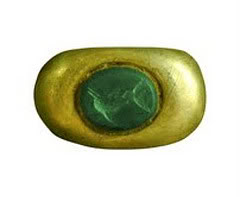
“Marcus took it from him and bent to examine it. It was a heavy signet-ring; and on the flawed emerald which formed the bezel was engraved the dolphin badge of his own family …” (The Eagle of the Ninth)
The Eagle of the Ninth was first published in 1954. Various books are linked by this Dolphin ring of the Aquila family. In TThe Silver Branch from 1957 Flavius, a descendent of Marcus, and his kinsman Justin lead a resistance movement to the Saxon attacks on Britain.Then in Frontier Wolf, published in 1980, Alexios (“a scion of Marcus’ blood”) leads the Frontier Wolves who manned an outpost in the far north of Roman Britain. The much earlier (1959) The Lantern Bearers was also set in Roman Britain, during the coming of Anglo-Saxon invaders. The nineteen-year-old Aquila (again, a descendant of Marcus) sees his home and family destroyed by Anglo-Saxon invaders and becomes a slave, before escaping to join the free men in Wales where he meets a young leader Artos the Bear (Rosemary Sutcliff’s interpretation of King Arthur). Sword At Sunset (1963) follows the story of Artos the Bear.
In Dawn Wind, published in 1961, Owain is fourteen when the British war-hosts gather to hold what territory they still had against the Saxons. He hopes that one day ‘the dawn wind might blow and some part of the Britain he had known might be restored.’ Owain too is descended from Marcus. The Dolphin ring turns up again in Sword Song (1991), and finally in The Shield Ring (1956) a group of Vikings, including Beorn – last descendent of the Marcus line, though now with Norse blood, lives in the Fells of Lakeland, trying to hold out against the resources of Norman England.
In summary, chronologically:
Frontier Wolf (1980) – 4th century
The Lantern Bearers (1959) – 5th century
Sword At Sunset (1963) – 5th century
Dawn Wind (1961) – 6th century
Sword Song (1997) – 10th century
The Shield Ring (1956) – 11th century
“Angharad wore around her neck a heavy golden ring, much battered and set with some dark green stone……(with a dolphin) engraved on it” (Sword Song)

Between reading 5 books of Sharon Penman & 9 of Lindsey Davis, as well as having visited Etruria & Hadrian’s Wall, I wanted to learn more about Roman Britain, so I was joyful to discover Rosemary Sutcliff for the first time. The title, The Eagle of the Ninth, intrigued me. Having studied archaeology because I’d read Greek & Roman mythology since the age of 10, I was fascinated by the idea of Rosemary’s being inspired by that Eagle at the age of 5. I now have about 8 of her books, & have ordered another 5. I just curl up with the dog and read and read and read!
LikeLike
Very good to hear from another reader!
LikeLike
Although inspired by a genuine Roman antique, this particular ring doesn’t in fact exist in reality. I spotted its picture (battered and complete with dolphin) in a catalogue of antiquities, and “recognized” it immediately. The original was silver and garnet, but hey presto! a touch of photoshop magic and it was transformed into Marcus’ gold and emerald ring. Rosemary Sutcliff, I’m sure, would have come across a similar photograph at some point when browsing reference books and had the same sort of “aha” moment. I had intended to use this image as an illustration for the article about Rosemary Sutcliff’s work which I was writing at the time:
Rosemary Sutcliff (1920-1992)
http://www.historicalnovels.info/Rosemary-Sutcliff.html
In the event it wasn’t used for this purpose, but for me it continues to epitomise the solid, workmanlike soldier’s ring I always imagined the Aquila family heirloom to be.
LikeLike
This illustration is brilliant! It looks almost exactly like I always imagined the ring! I wasn’t aware there might have been a real ring that inspired the fictional one – hope you can find out more about it …
LikeLike
I am not sure if the ring appears in Sword at Sunset.
LikeLike
The ring does indeed appear twice in Sword at Sunset. Aquilla entrusts it to Artos to pass on to Flavian the night before the battle at Breedon Hill (in which he is killed) and at the end, Flavian passes it onto his on son, and goes to his death in battle with a white mark on his hand where the ring had long been.
BUT does it not also crop up centuries later, in The Armourer’s House? It’s been a while since I read that, but I remember that the house in Henry VIII tudor London had dolphins carved on the front, “like those on Uncle Martin’s RING…”
Nice to see these chronologically laid out!
LikeLike
Can you tell us about the actual ring that was your aunt’s inspiration for this? Is the photograph of the ring she was thinking of? Where is it now, and when did she first come across it? Is there anything in its own story as far as the archaeological context can tell us that contributed to her ideas? I have always wanted to know more about it, and would love to hear any other details you can share!
LikeLiked by 1 person
I am afraid I do not know, although I suspect that there are clues in her diaries which I have. That is not her ring, but an illustration.
LikeLike
Ah well! Any time you feel like writing up the diary clues we’d love to hear more about it.
LikeLike